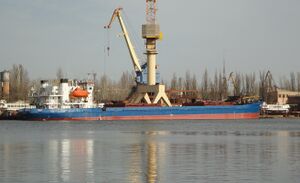Omskiy type ship
Topic: Engineering
 From HandWiki - Reading time: 3 min
From HandWiki - Reading time: 3 min
 Omskiy-143 at Khersonskiy Sudoremontnyy Zavod
| |
| Class overview | |
|---|---|
| Name: | Omskiy type |
| Operators: |
|
| Subclasses: |
|
| Built: | 1972–1995 |
| Completed: | ~140 |
| General characteristics | |
| Type: | Dry cargo ship |
| Displacement: | Project 1743: 2,528 GRT |
| Length: | 108 m (354 ft 4 in) |
| Beam: | 15 m (49 ft 3 in) |
| Draft: | 1.0 m (3.3 ft) |
| Decks: | 1 |
| Propulsion: | 2 × diesel engines |
| Speed: | 9 knots (17 km/h; 10 mph) |
| Range: | 10 days |
| Crew: | 11 |
The Project 1743 Omskiy type ships are a class of large dry cargo ships built from 1972 until 1995 in the Soviet Union, Russia , and Romania.
Description
Omskiy type ships are around 108 m (354 ft) long with a beam of 15 m (49 ft). They have a draft of 3.3 ft (1.0 m) and a displacement of roughly 2,500 GRT.[1] They are big dry cargo ships with four covered holds, as well as a double bottom and sides.[2] Omskiy type ships are powered by two diesel engines with 515 kW of power each.[1]
There are three types of Omskiy type ships: Project 1743, Project 1743.1, and Project 1743.7. Project 1743 are the original cargo ships, while the 1743.1 and 1743.7 variants are modernized subclasses. The 1743.1 ships have a different interior of the superstructure as well as the placement of the two funnels and the form of the stern. The 1743.7 ships are longer and have two cranes for loading and unloading.[2]
History
Omskiy type ships were built in the Soviet Union and then Russia from 1972 until 1995, and in Romania from 1977 until 1991. The Project 1743.1 and 1743.7 were all built in the 1990s- with modernized equipment for river-sea operations. Around 140 ships were built in total, with 108 from Project 1743, 26 from Project 1743.1, and 7 from Project 1743.7.[2]
Most of the ships were designed for use in the Lena and Ob-Irtysh river basins, and some were named after Siberian towns. A few ships were delivered to the Yenisey and Amur river basins, or to Europe. In the 1990s, most of the ships were transferred out of Russia to Europe or East Asia, and some were sold to foreign shipping lines to take on more convenient flags.[2]
List of ships
| Ship name | Flag | Built | Owner | Image | Notes |
|---|---|---|---|---|---|
| Omskiy-4 IMO number: 8943105 |
St. Petersburg |
1975
Krasnoyarsk Shipyard |
[3] | ||
| Omskiy-14 IMO number: 8874914 |
Taganrog |
April 1980 | Oceanic Bay Investments | [4] | |
| Omskiy-20 IMO number: 8943090 |
Bor |
1974
Krasnoyarsk Shipyard |

|
[5] | |
| Omskiy-105 (Captain Podoljan) IMO number: 8866747 |
Taganrog |
October 1980
Șantierul Naval Oltenița |
Mardim | [6] | |
| Omskiy-107 IMO number: 8866759 |
Taganrog |
August 1981 | River and Sea Shipping Agency | [4] | |
| Omskiy-109IMO number: 8875621 | Nikolayevsk-na-Amure |
January 1983 | Amur Shipping Company | [4] | |
| Omskiy-121 IMO number: 8871194 |
Moroni |
1984
Șantierul Naval Oltenița |

|
[7] | |
| Omskiy-132 IMO number: 8873025 |
St. Petersburg |
1988 | 
|
[8] | |
| Omskiy-133 IMO number: 8873336 |
St. Petersburg |
31 July 1988
Șantierul Naval Oltenița |
North Western Fleet Company | 
|
[9] |
| Omskiy-135 IMO number: 8881723 |
St. Petersburg |
1988
Șantierul Naval Oltenița |

|
[10] | |
| Omskiy-143 IMO number: 8869385 |
Taganrog |
1990 | Bolshaya Sadovaya | 
|
[11] |
| Omskiy-205 (Skif) IMO number: 8881814 |
St. Petersburg |
1993
Krasnoyarsk Shipyard |
Marship | Possibly damaged by a mine during the 2022 Russian invasion of Ukraine.[4][12] | |
| Omskiy-207 IMO number: 9132363 |
Astrakhan |
1995 | 
|
[13] |
References
- ↑ 1.0 1.1 "Omskiy Type Project 1743.1" (in en). https://www.2k-global.com/omskiy-type-project.
- ↑ 2.0 2.1 2.2 2.3 "omskiyEn | Ship Trade House" (in en-GB). 2017-10-11. https://shiptradehouse.com/en/omskiyen/.
- ↑ "Omskiy-4" (in en). https://www.balticshipping.com/.
- ↑ 4.0 4.1 4.2 4.3 Register of Ships. Extract: Coastal (River-Sea) and Inland Navigation Ships. Russian Maritime Register of Shipping. 2011. http://info.rs-head.spb.ru/extract.pdf.
- ↑ "Omskiy-2" (in en). https://www.balticshipping.com/.
- ↑ "OMSKIY-105". https://lk.rs-class.org/regbook/regbookVessel?namer=803970&ln=en.
- ↑ "Ship OMSKIY 121 (General Cargo) Registered in Comoros - Vessel details, Current position and Voyage information - IMO 8871194, MMSI 620139000, Call Sign D6A2139" (in en). https://www.marinetraffic.com/en/ais/details/ships/shipid:700256/mmsi:620139000/imo:8871194/vessel:OMSKIY_121.
- ↑ "Ship OMSKIY 132 (General Cargo) Registered in Palau - Vessel details, Current position and Voyage information - IMO 8873025, MMSI 511100649, Call Sign T8A3823" (in en). https://www.marinetraffic.com/en/ais/details/ships/shipid:346106/mmsi:511100649/imo:8873025/vessel:OMSKIY_132.
- ↑ "OMSKIY-133". https://lk.rs-class.org/regbook/regbookVessel?namer=886884&ln=en.
- ↑ "Ship OMSKIY 135 (General Cargo) Registered in Russia - Vessel details, Current position and Voyage information - IMO 8881723, MMSI 273318800, Call Sign UIWY" (in en). https://www.marinetraffic.com/en/ais/details/ships/shipid:346217/mmsi:273318800/imo:8881723/vessel:OMSKIY_135.
- ↑ "Ship OMSKIY 143 (General Cargo) Registered in Russia - Vessel details, Current position and Voyage information - IMO 8869385, MMSI 273396000, Call Sign UHTD" (in en). https://www.marinetraffic.com/en/ais/details/ships/shipid:349647/mmsi:273396000/imo:8869385/vessel:OMSKIY_143.
- ↑ Dixon, Gary (29 March 2022). "Speculation grows after Russia says cargo ship hull breached by ‘strong waves’". Trade Winds. https://www.tradewindsnews.com/casualties/speculation-grows-after-russia-says-cargo-ship-hull-breached-by-strong-waves-/2-1-1192489.
- ↑ "Ship OMSKIY 207 (General Cargo) Registered in Russia - Vessel details, Current position and Voyage information - IMO 9132363, MMSI 273332310, Call Sign UEUR" (in en). https://www.marinetraffic.com/en/ais/details/ships/shipid:347041/mmsi:273332310/imo:9132363/vessel:OMSKIY_207.
 KSF
KSF
